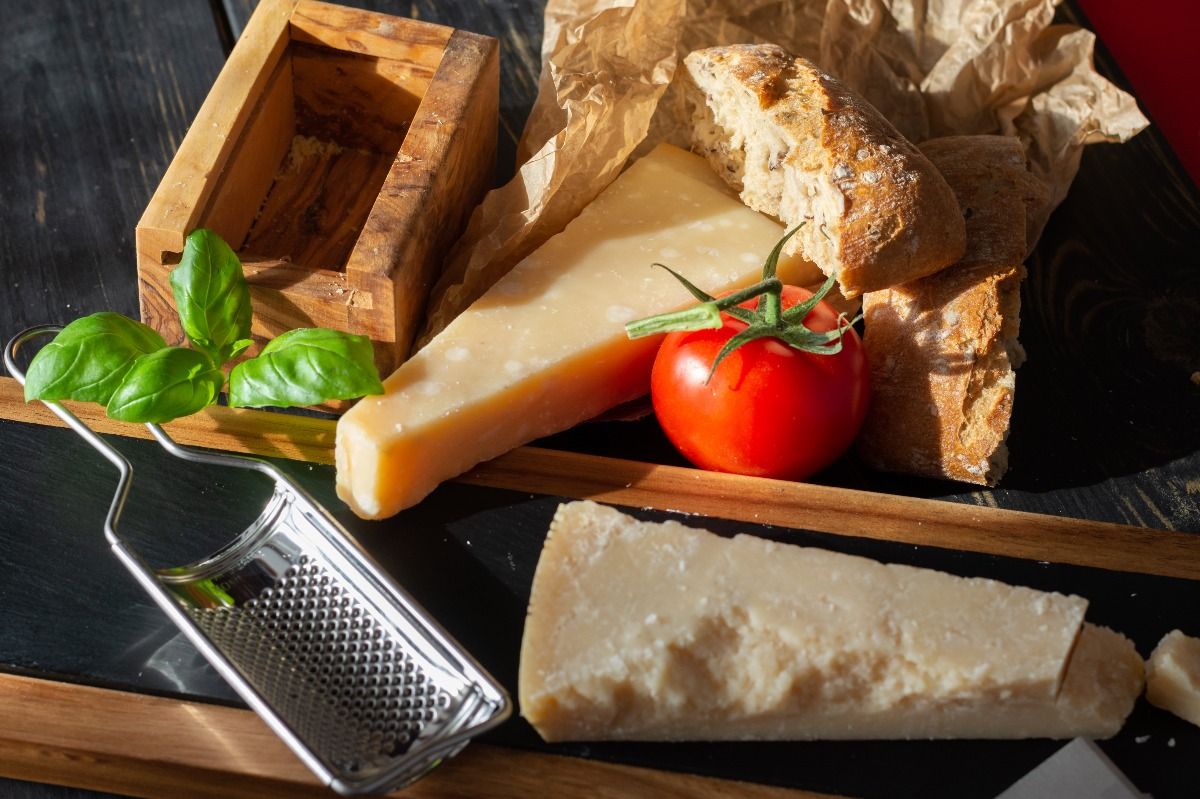The creme de la creme of dairy products, Parmigiano-Reggiano reigns supreme among cheeses and is held with the utmost reverence throughout Italy. Seriously, it's deemed the "King of Cheese" there — and for good reason! Parmigiano-Reggiano is genuinely amazing in . . . everything. It's perfectly crumbly, rich, and salty, with chewy, crunchy bits embedded throughout.
Parmigiano-Reggiano elevates any dish it comes into contact with, from main courses and appetizers to charcuterie plates and even dessert. Shards of Parmigiano-Reggiano with savory prosciutto, crusty baguette and briny olives combine to create one of the most simply delicious platters imaginable. (I call it simplicity personified.)
"Culture" magazine beautifully encapsulates the essence of Parmigiano-Reggiano: It's "buttery," "crumbly," "nutty," "studded with crunchy amino acids crystals" and has a "characteristic umami." Simply referred to as Parm in colloquial settings among friends or at restaurants, the history and meaning of this cherished cheese belies its simple name. Parmigiano-Reggiano is really no more than milk, rennet and salt, but the quality of those products are absolutely pristine.
The comprehensive and incredibly thorough website for the Parmigiano-Reggiano Consortium, which serves as the primary source for this article, is a veritable treasure trove of Parm adoration. It notes that the cheese is "produced exclusively in the provinces of Parma, Reggio Emilia, Modena, Bologna to the left of the Reno river, and Mantua to the river of the Po river." This land of this specific region is "characterized by a unique and intense bacterial activity of the autochthonous microbial flora," which is to say that Parmigiano-Reggiano cannot be produced anywhere else on earth. It has been produced in this particular region for more than 1,000 years!
The history of Parmigiano-Reggiano dates back to the Middle Ages, when monks created the cheese in order to produce a product that was long-lasting. They used the "salt from the salsomaggiore salt mines and the milk of the crows bred in the ranges," according to the Consortium. In the 1600s, a special designation was made for the cheese in order to ensure that no competition could claim it "from Parma."
Production of Parmigiano-Reggiano hasn't changed, though new technologies have updated the specifics of its creation. In 1934, the varying regions "agreed on the need to approve a mark of origin for their cheese." Interestingly enough, there's even a governing body — the aforementioned Consortium — which acts as the overseer of the cheese and is committed to its preservation. (You see, I wasn't kidding when I said that Italians are very serious about this cheese!)
In 1992, "protected designations of origin" were approved in order to ensure that none of the Parmigiano-Reggiano impersonators would ever flourish. This cheese is often imitated, but never duplicated! Believe it or not, Forbes even notes that there is a museum in Parma dedicated to spotlighting the "imitators."
Fun fact: You can also now book Italian Airbnbs that spotlight Parmigiano-Reggiano. They're strategically situated near production facilities that offer tours and tastings. Oh, what a world!
How Parmigiano-Reggiano is made
According to the Consortium, the specially selected and raised cattle that produce this iconic cheese graze on "locally grown forage," and their feeding adheres to "strict specification that bans the use of silage, fermented feeds and animal flour." Parmigiano-Reggiano is produced in bell-shaped copper vats, and a singular wheel of the prestigious cheese calls for about 550 liters of milk. The milk "slowly and naturally coagulates with the addition of rennet and a whey starter."
After the curd is broken down with a "spino," it's cooked and the "cheesy granules sink to the bottom of the cauldron forming a single mass," which then results in two wheels of Parmigiano-Reggiano. The wheels are then "immersed in a saturated solution of water and salt," which is the last stop prior to maturation. Most are aged 12 months, but some can be aged up to as long as 40 months or more.
How to buy and grate this cheese
When discussing Parmigiano-Reggiano, we also must note "parmesan," which is actually quite different. While also totally delicious, it's not as regulated, prestigious or expensive as Parmigiano-Reggiano. An example of a delicious Parmesan cheese is Grana Padano.
Parmigiano-Reggiano has no additives or preservatives. It's also halal, kosher, lactose-free and organic. It's 100% natural and made of 30% water and 70% nourishing substances. Try to do your best to steer clear of pre-shredded or pre-grated Parmigiano-Reggiano, because it often contains additives like cellulose to keep it from clumping. Your best bet is to buy a hunk of cheese and grate it yourself using a microplane, vegetable peeler, or another similar tool.
***
Bright and acidic with bursts of flavor from pistachios and Parmigiano-Reggiano, this pesto adds an appealing and sometimes hard-to-identify flavor to sandwiches, pastas or anything else that it's slathered on.
Recipe: Fennel Frond Pesto
Ingredients
- 2 1/2 cups basil
- 1 cup fennel fronds (just the frilly greens)
- 1/2 - 3/4 cup EVOO
- 3/4 cup grated Parmigiano-Reggiano
- 1/4 cup shelled pistachios
- 1-2 garlic cloves
- Kosher salt
- Cracked black pepper
Instructions
- In blender, food processor or with mortar and pestle, crush or blend Parm, pistachio, garlic, salt and pepper together.
- Add basil, crush or blend, add fennel fronds, crush or blend, and then slowly stream oil until the mixture becomes smooth and near-homogenous.
- Season to taste.
***
A dozen more pairing ideas:
- Aged Parm with honey, baguette and prosciutto
- Antipasti (Mutz, Parm, nuts, olives, bread, honey, pickled mustard seeds, wine, balsamic)
- Braciol
- Cantaloupe, bresaola, Parm
- Crostini with ricotta, ramps and Parm
- Endive, shaved Parm, Parm vinaigrette
- Parm and leek soup
- Parm porchetta
- Parm stuffed veal chops
- Raw corn, pancetta and Parm
- Specialty Parm grilled cheese
- Sunchoke and Parm
More from Michael La Corte:



Shares